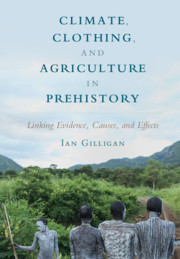Description
Climate, Clothing, and Agriculture in Prehistory
Linking Evidence, Causes, and Effects
Author: Gilligan Ian
The first book on the origin of clothes shows why climate change was crucial - for the origin of agriculture too.
Language: English
Approximative price 104.06 €
In Print (Delivery period: 14 days).
Add to cart
Climate, Clothing, and Agriculture in Prehistory
Publication date: 12-2018
344 p. · 18.3x26.1 cm · Hardback
Publication date: 12-2018
344 p. · 18.3x26.1 cm · Hardback
Climate, Clothing, and Agriculture in Prehistory
Publication date: 12-2018
342 p. · 17.8x25.4 cm · Paperback
Publication date: 12-2018
342 p. · 17.8x25.4 cm · Paperback
Description
/li>Contents
/li>Biography
/li>
Clothing was crucial in human evolution, and having to cope with climate change was as true in prehistory as it is today. In Climate, Clothing, and Agriculture in Prehistory, Ian Gilligan offers the first complete account of the development of clothing as a response to cold exposure during the ice ages. He explores how and when clothes were invented, noting that the thermal motive alone is tenable in view of the naked condition of humans. His account shows that there is considerably more archaeological evidence for palaeolithic clothes than is generally appreciated. Moreover, Gilligan posits, clothing played a leading role in major technological innovations. He demonstrates that fibre production and the advent of woven fabrics, developed in response to global warming, were pivotal to the origins of agriculture. Drawing together evidence from many disciplines, Climate Clothing, and Agriculture in Prehistory is written in a clear and engaging style, and is illustrated with nearly 100 images.
Part I. Introduction: 1. What separates us from nature?; Part II. Clothing in the Ice Age: 2. Climate change and the invention of clothes; 3. How clothes work to keep us warm; 4. The technology of Palaeolithic clothes; 5. Changing climates and early clothes; 6. Decorated clothes and Palaeolithic art; 7. Neanderthals and Tasmanians; 8. The value of making clothes visible; Part III. Global Warming and Agriculture: 9. Time for new clothes; 10. A half-baked revolution; 11. Agriculture and textiles in Eurasia; 12. Agriculture and textiles in the Americas; 13. Agriculture from Africa to Australia; Part IV. Feeding the Multitude: 14. A really revolutionary revolution; 15. Covering breasts and making more babies; Part V. Sedentism and Domestication: 16. Some loose ends; 17. Enclosure and fabrication; Appendix.
Ian Gilligan, one of the world's leading authorities on the origins of clothing, holds university degrees in medicine, psychology, prehistoric archaeology and biological anthropology, and is an Honorary Associate in the Department of Archaeology at the University of Sydney. He has authored a book on the clothing of Australian Aborigines and his work has been published and cited in numerous scientific journals.
© 2024 LAVOISIER S.A.S.
These books may interest you

The Development of Costume 160.25 €

Improving Comfort in Clothing 226.07 €


